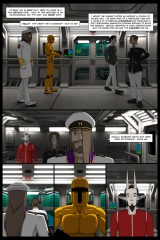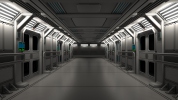The Heirotus observation booth is a lot more hands-on than the Templar equivalent depicted in The Dualist. While James has taken a more cautious approach in the past, he is personally invested. If this wasn’t already obvious, it will be made clear on the next page.
The sick bay design is an intentional comparison/contrast to the Psionic Observation Ward at Bethlehem Medical Centre, depicted in 2d and 3d in The Dualist. Psi-Obs is one of a small handful of 3d environments intentionally matched to its 2d predecessor. At the time the color choices was an intentional hospital green. The sickbay color choice is intended to echo that environment and to key to Thad’s higher self, who sports one of the series “reserved” colors.
Templar orders were to detain, hold for pickup and observe. They operate under a strict doctrine of non-interference, manipulating the subjects environment to coerce them into making the leap themselves. Heirotus isn’t hung up in a soup of initiatic traditions – acquisition and utilization are much less ephemeral. Their budget also has a few more zeroes before the decimal point so they can afford full-featured hospitals aboard company-owned deep space battleships, while the Templar make due with whatever they can get their hands on. In the case of Thule Garrison, a fallout shelter in a pocket universe.
Grij and Andreissen are blurred out for plot reasons as well as style – the depth of field shots look good and they put the focus where it needs to be in both panels – on James. Grij has effectively been written out – James accurately summarizes what Grij is upset about in panel one, a point he’s tried to belabor previously.
I’ve been holding onto that point since high school. I let it slip in Water and figure that it’s important enough to merit an exclusion from my habit of mentioning important things exactly once. The doctor references the chromosome difference in her giant wall of text in panel two, hints at blood type being a potential problem, and then sweeps both points under the rug. Life out there began here and was adapted to fit. While “recruitment” was thorough it was by no means all-inclusive – it’s the sort of story point I could easily expend entire books – or chapters of books – exploring but that’s part of the foundation of the story I want to tell, not the story itself. Exported humans are better at space than home-grown humans – it’s a thing, but it’s not a huge thing in the context of Transitional Voices.
Delving into the genetic enhancements of space-based humans sure would make for a nice “expanded universe” story. It’s not the only idea in this chapter that I wouldn’t mind expanding upon. Fire has more than a few – it’s probably the most conceptually-dense chapter of ATC to date. This chapter was written with a “throw everything at the wall” approach – while some of the story elements are fairly recent developments, none of the background in the chapter is new. None of it is even from this decade, and some of it isn’t even from this century. I finally stopped writing around the plot in DCR, and now at long last the color work is finally on track.
Tech note – The numbers on the wall panel are green because they match the sensor readings in the corridor. 1.02 is the atmospheric pressure and 295 is the temperature. The temperature is in Kelvin and atmospheric pressure uses its own No-Units-For-Plot-Reasons formula in which “1” represents “14.7 pounds per square inch.” If the readings were at variance with the adjacent compartment the numbers would be in yellow or red, depending.
Speaking of No-Units-For-Plot-Reasons, note that James refers to Thad without using gendered dialogue. The doctor does not – to the doctor the subject is a human male with anomalous brain function. James knows better, and while he doesn’t feel the need to brief Kelly his knowledge of the subject has influenced his choice of words. Consciously considering this piece of information is a recent development; it may result in edits at some later date though I don’t believe any are necessary at present.
The next page is almost complete. I need to get the one after rendered or at least ready for rendering so I can finish it, but it’s good to go otherwise. I promise it’ll be just as relevant to the overplot, albeit a bit more specific in its implications. Focused, even.
I mentioned Grij being written out – while he has a small appearance in the background of the next page this is his last appearance in Transitional Voices. Dialogue placement in panel three reinforces this fact – putting the word irrelevant near a less-distinct-than-usual Grij makes the point. Reading left-to-right it also makes James’ facial expression the last story element on the page. I’m pleased with how that arrangement of elements turned out.
Mastering notes, 2016.12.07 – Minor dialogue adjustments to the CMO’s second block of dialogue in panel two.








